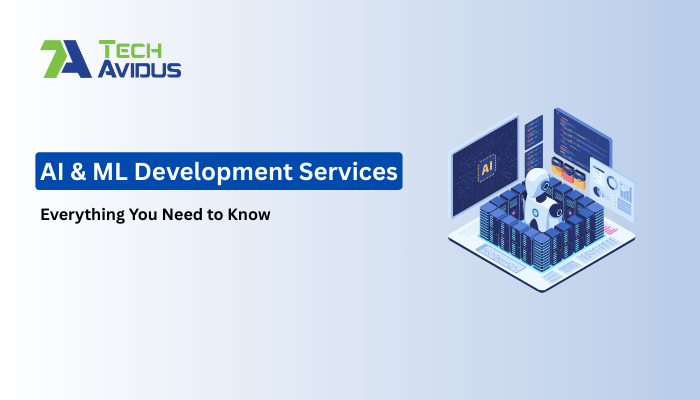
In today’s fast-paced digital world, Artificial Intelligence (AI) and Machine Learning (ML) have moved from buzzwords to business essentials. Whether you're streamlining operations, enhancing customer experience, or unlocking new revenue streams, AI and ML development services are redefining how businesses operate.
But what exactly do these services include? How can they benefit your organization? And what should you look for when hiring a development partner?
This guide answers all those questions and more.
AI and ML development services encompass designing, deploying, and maintaining systems that mimic human intelligence and learn from data. These services can include:
These solutions enable businesses to automate decision-making, identify patterns in large datasets, and improve overall efficiency.
There are several reasons why companies across industries are prioritizing AI and ML solutions:
From healthcare and finance to logistics and e-commerce, the possibilities are vast.
Here’s a breakdown of key benefits:
AI and ML have found practical applications across various sectors:
E-commerce
Healthcare
Finance
Manufacturing
Marketing
Transportation
These use cases highlight how AI/ML can create tangible business value.
Building an AI or ML solution isn’t just about writing code. It follows a systematic process:
Each step requires a mix of technical skill and domain understanding.
Selecting the right development partner is crucial for a successful AI/ML initiative. Here’s what to consider:
Working with a seasoned partner helps avoid costly missteps and accelerates your go-to-market.
The cost of AI/ML development services can vary widely depending on:
As a rough estimate, simple AI/ML models may start at a few thousand dollars, while enterprise-grade solutions could require a six-figure investment. However, the long-term ROI often justifies the upfront costs.
AI and ML development services offer immense potential to future-proof your business, unlock hidden insights, and deliver innovative user experiences. As adoption grows, businesses that act early will gain a significant competitive edge.
Whether you're just beginning your AI journey or looking to scale existing efforts, understanding the landscape is the first step. With the right strategy, tools, and partners, the possibilities are endless.
👉 Ready to innovate with AI/ML? Schedule a free consultation with our team.
What is AI development, and how does it work?
Answer: AI development involves designing and building intelligent systems that can simulate human-like decision-making and learning. It typically includes data collection, algorithm selection, model training, and deployment. AI systems use techniques like machine learning (ML), natural language processing (NLP), and computer vision to learn from data and perform tasks such as predictions, automation, or analysis without being explicitly programmed for every scenario.
Is AI suitable for small businesses?
Answer: Yes, AI is increasingly accessible and highly beneficial for small businesses. From automating customer service with chatbots to predicting sales trends or optimizing marketing campaigns, small businesses can use lightweight and cost-effective AI solutions. With cloud-based tools and open-source frameworks, small businesses don’t need massive infrastructure or data science teams to get started.
How to automate customer support using AI?
Answer: AI can automate customer support through tools like:
What is the difference between AI and ML?
Answer: Artificial Intelligence (AI) is the broader concept of machines performing tasks that typically require human intelligence—like problem-solving, learning, and perception. Machine Learning (ML) is a subset of AI that enables systems to learn from data and improve over time without being explicitly programmed. All ML is AI, but not all AI is ML.
Can I integrate ML with my existing ERP system?
Answer: Yes, ML can be integrated with ERPs to enhance forecasting, inventory management, anomaly detection, and customer insights. APIs and middleware can connect your ML models to ERP platforms like SAP, Oracle, or Odoo, enabling real-time data flow and automation.
What is the difference between traditional AI and Generative AI (GenAI)?
Answer: Traditional AI is designed to make decisions or predictions based on predefined rules or patterns learned from data (e.g., classification, forecasting). Generative AI (GenAI), like ChatGPT or DALL·E, is focused on creating new content—text, images, code, or audio—based on training data. It uses models like large language models (LLMs) and diffusion models to generate human-like outputs and is a major leap forward in human-AI interaction.

Bhavesh Ladva is a seasoned AI Developer with over 10 years of experience in machine learning, deep learning, and NLP. He has built scalable AI solutions across industries, leveraging technologies like Python, TensorFlow, and cloud platforms. Bhavesh is passionate about ethical AI and constantly explores innovative ways to solve real-world problems.
Our Top 1% Tech Talent integrates cutting-edge AI technologies to craft intelligent, scalable, and future-ready solutions.
All Rights Reserved. Copyright © 2025 | TechAvidus